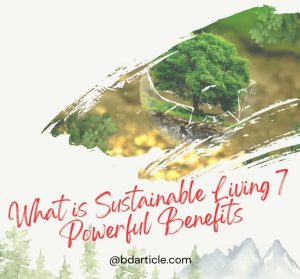What is sustainable living? It’s a lifestyle that prioritizes reducing our environmental impact by making conscious choices in our daily lives. From the food we eat to the energy we use, sustainable living focuses on preserving natural resources for future generations. But it’s more than just a trend—it’s a necessity today. This article, Sustainable Living, provides examples and highlights seven powerful benefits of adopting this lifestyle. Whether you’re curious about examples of sustainable living or want to learn how to live a sustainable lifestyle, this guide has you covered.

What is Sustainable Living?
Sustainable living is about making choices that minimize environmental harm and promote long-term ecological balance. It involves reducing waste, conserving energy, and supporting eco-friendly practices. For a deeper understanding, you can refer to resources like “Wh”t is sustainable living Wikipedia” o” download a “Wh”t is sustainable living PDF” f”r a comprehensive overview.
This lifestyle is not about individual actions—it’s about creating a collective impact. From using renewable energy to supporting local farmers, sustainable living examples show how small changes can make a big difference.
Why is Sustainable Living Important?
The importance of sustainable living cannot be overstated. Adopting a sustainable lifestyle is crucial, with climate change, deforestation, and pollution threatening our planet. “Causes of Global Warming” include excessive carbon emissions, deforestation, and industrial pollution—all of which can be mitigated through sustainable practices.
Living sustainably can reduce our carbon footprint, protect natural habitats, and ensure a healthier planet for future generations. This is why sustainable living is a personal choice and a global responsibility.
7 Powerful Benefits of Sustainable Living
- Reduces Environmental Impact
One of the most significant benefits of sustainable living is its positive impact on the environment. We can significantly lower our ecological footprint by using renewable energy, reducing waste, and conserving water. Switching to solar power or driving an electric vehicle are excellent examples of sustainable living that reduce reliance on fossil fuels. - Saves Money
Sustainable living often leads to long-term cost savings. Energy-efficient appliances, reusable products, and homegrown vegetables can reduce monthly expenses. Over time, these savings add up, making sustainable living eco-friendly and budget-friendly. - Improves Health
A sustainable lifestyle often involves eating organic, locally sourced foods and reducing exposure to harmful chemicals. This can lead to better physical health and overall well-being. Activities like cycling or walking instead of driving contribute to a healthier lifestyle. - Supports Local Economies
Sustainable living encourages supporting local businesses and farmers. By buying locally produced goods, you help boost the local economy and reduce the carbon emissions associated with transporting goods over long distances. - Promotes Biodiversity
Sustainable practices like organic farming and reducing plastic use help protect ecosystems and wildlife. By preserving natural habitats, we contribute to the planet’s biodiversity, ensuring that future generations enjoy a rich and diverse environment. - Encourages Innovation
The shift toward sustainable living drives innovation in technology and design. From electric cars to biodegradable packaging, sustainable living examples showcase how creativity and technology can work together to solve environmental challenges. - Fosters a Sense of Community
Sustainable living often involves community initiatives like urban gardening, carpooling, or recycling programs. These activities unite people, fostering community and shared responsibility for the planet.
How to Live a Sustainable Lifestyle
Adopting a sustainable lifestyle doesn’t have to be overwhelming. Here are some practical steps to get started:
- Reduce, reuse, and recycle to minimize waste.
- Switch to renewable energy sources like solar or wind power.
- Support local and organic food producers.
- Use public transportation, carpool, or bike to reduce carbon emissions.
- Invest in energy-efficient appliances and products.
For more detailed guidance, you can explore a “Sustainable Living PPT” or read a “Sustainable Living Essay” to gain deeper insights.
Sustainable Living Examples
Here are some real-life sustainable living examples to inspire you:
- Installing solar panels to generate clean energy.
- Growing your vegetables in a backyard garden.
- Using reusable bags, bottles, and containers to reduce plastic waste.
- Composting organic waste to create nutrient-rich soil.
- Participating in community clean-up drives or tree-planting events.
These examples demonstrate how small changes can lead to significant environmental benefits.
Conclusion
What is sustainable living? It is a commitment to making choices that benefit the planet and its inhabitants. Understanding why sustainable living is essential and embracing its principles can create a healthier, more sustainable future. From reducing environmental impact to fostering innovation, the benefits of sustainable living are undeniable.
Whether you’re looking for examples of Sustainable Living, tips on how to live a sustainable lifestyle, or resources like a “What is sustainable living PDF,” this guide provides a starting point for your journey. Start today and be part of the movement toward a greener, more Sustainable World.
#What_is_sustainable_living #What_is_sustainable_living_PDF #What_is_sustainable_living_Wikipedia

